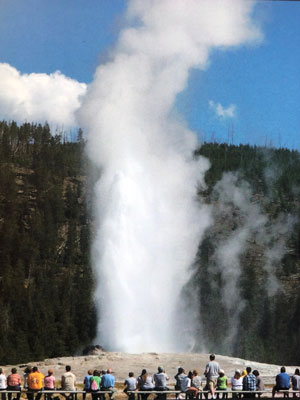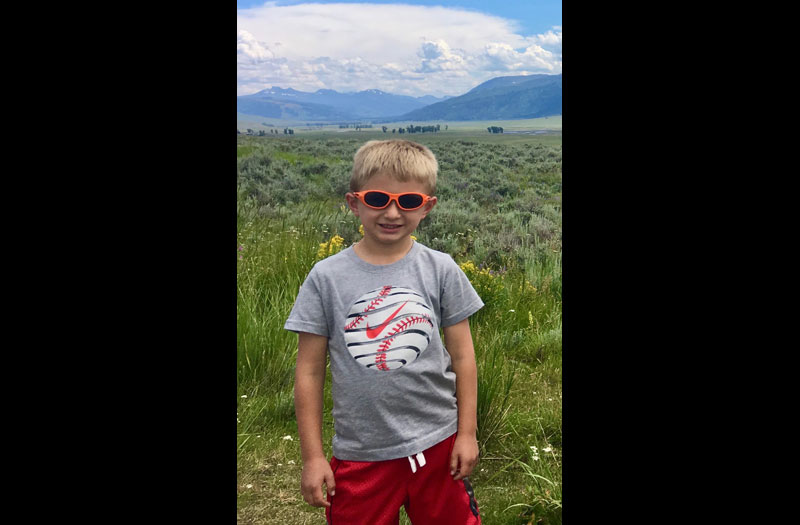Karson is 8 years old. He enjoys writing stories. He welcomes your comments
Previous stories posted by Karson Jones
Some States I Have Visited by Karson Jones
Karson’s Favorite Train – The White Pass & Yukon Railway: A Story by Karson Jones
The Best Giant’s Catcher – Buster Posey – A Short Story by Karson Jones
I have visited Yellowstone National Park twice in my life, first when I was three years old and later when I was six. Yellowstone was the first national park established in the United States and in the world. Yellowstone became a park in 1872 when President Ulysses S. Grant signed the law passed by Congress. The park includes parts of three states: Idaho, Montana and Wyoming with the largest part in Wyoming.
I have been to other national parks including The Grand Canyon, Yosemite, Arches and Grand Teton. My favorite national park is Yellowstone. I like all the wildlife and especially the geysers.

Old Faithful in Yellowstone Park, photo by Krissy Jones
The Geysers in Yellowstone park are the most well known but there are other geyser in many places in the United States including The Geysers in California’s Sonoma and Lake Counties—the largest geothermal field in the world. The Geysers is very close to where I live but I like Yellowstone because it has more wildlife and beautiful scenery.
One of the animals I’ve seen in Yellowstone is bears such as black bears and grizzly bears. Black bears are not as exciting for me because we have them where I live even in our own yard sometimes. Grizzly bears are extinct in California even though they appear on the State flag. Grizzly bears have a hump on their back and that makes it easy to tell the difference with black bears which do not have a hump. Grizzly bears are bigger and scarier than black bears. Other animals I’ve seen in Yellowstone include bison and bighorn sheep. There are lots of other animals that I have not seen or was too young to remember.

Bison in Yellowstone Park, photo by Krissy Jones
Yellowstone is home to the largest concentration of mammals in the lower 48 states. In addition to having a diversity of small animals, Yellowstone is notable for its predator–prey complex of large mammals, including eight ungulate species (bighorn sheep, bison, elk, moose, mountain goats, mule deer, pronghorn, and white-tailed deer) and seven large predators (black bears, Canada lynx, coyotes, grizzly bears, mountain lions, wolverines, and wolves).
The wildflowers in Yellowstone make everything very colorful. I don’t know many wildflowers by name but here is a list of many that can be found there.
Wildflowers such as lupine (Lupinus argenteus) and arnica (Arnica cordifolia) often grow under the forest canopy, but the most conspicuous wildflower displays occur in open meadows and sagebrush-steppe. The appearance of springbeauties (Claytonia lanceolata), glacier lilies (Erythronium grandiflorum), and steershead (Dicentra uniflora) announce spring in the park. Soon colors splash the slopes, especially on the northern range—yellow from arrowleaf balsamroot (Balsamorhiza sagittata), white from phlox (Phlox multiflora), reds and oranges from paintbrush (Castilleja), and blue from penstemon (Penstemon montanus) and lupine. Goldenrod (Solidago missouriensis) and purple asters indicate the coming of fall.
I’ve seen many things in Yellowstone and I’ve told you about some of them. You can see more in the video below.


Nice job Karson.
Yellowstone sounds great from your article. I have never been to that park. I would like to see the Grizzly Bears. Keep up the good writing. I do like your sunglasses.
Terry
Karson, this was a fantastic report on Yellowstone! Like Terry, I haven’t been there yet, but I really want to go some day. It would be nice to go together so you can be my guide. I’d like to see some grizzly bear, wolves, bison, and elk in the wild. I’d also like to see the geysers and hot mineral pools, and the waterfalls. Well done!